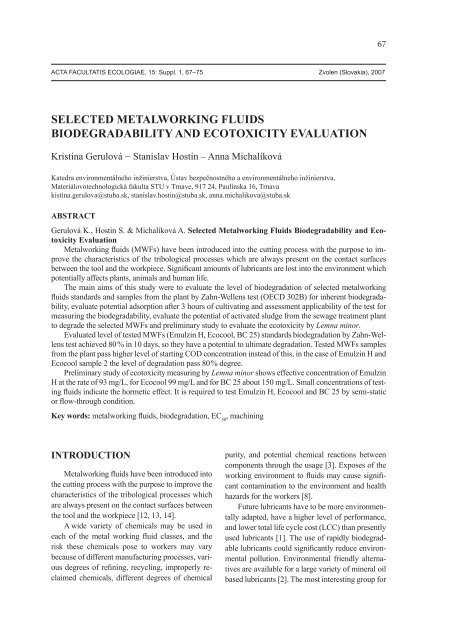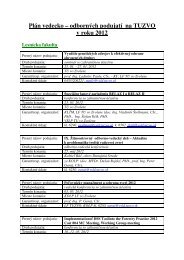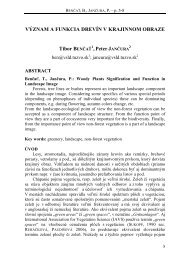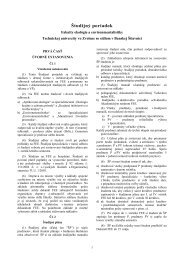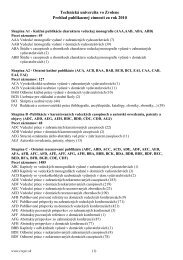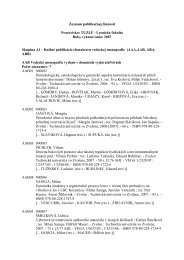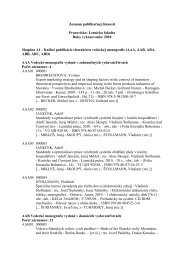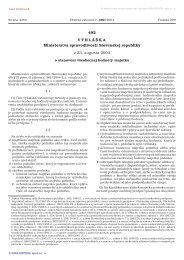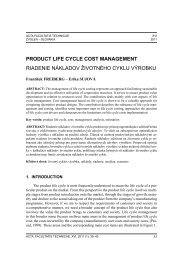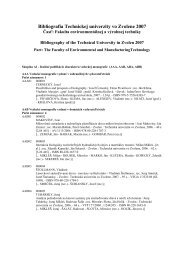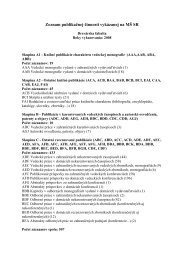67ACTA FACULTATIS ECOLOGIAE, 15: Suppl. 1, 67–75 Z<strong>vo</strong>len (Slovakia), 2007SELECTED METALWORKING FLUIDSBIODEGRADABILITY AND ECOTOXICITY EVALUATIONKristína Gerulová − Stanislav Hostin – Anna MichalíkováKatedra environmentálneho inžinierstva, Ústav bezpečnostného a environmentálneho inžinierstva,Materiálo<strong>vo</strong>technologická fakulta STU v Trnave, 917 24, Paulínska 16, Trnavakistína.gerulova@stuba.sk, stanislav.hostin@stuba.sk, anna.michalikova@stuba.skABSTRACTGerulová K., Hostin S. & Michalíková A. Selected Metalworking Fluids Biodegradability and EcotoxicityEvaluationMetalworking fluids (MWFs) have been introduced into the cutting process with the purpose to improvethe characteristics of the tribological processes which are always present on the contact surfacesbetween the tool and the workpiece. Significant amounts of lubricants are lost into the environment whichpotentially affects plants, animals and human life.The main aims of this study were to evaluate the level of biodegradation of selected metalworkingfluids standards and samples from the plant by Zahn-Wellens test (OECD 302B) for inherent biodegradability,evaluate potential adsorption after 3 hours of cultivating and assessment applicability of the test formeasuring the biodegradability, evaluate the potential of activated sludge from the sewage treatment plantto degrade the selected MWFs and preliminary study to evaluate the ecotoxicity by Lemna minor.Evaluated level of tested MWFs (Emulzin H, Ecocool, BC 25) standards biodegradation by Zahn-Wellenstest achieved 80 % in 10 days, so they have a potential to ultimate degradation. Tested MWFs samplesfrom the plant pass higher level of starting COD concentration instead of this, in the case of Emulzin H andEcocool sample 2 the level of degradation pass 80 % degree.Preliminary study of ecotoxicity measuring by Lemna minor shows effective concentration of EmulzinH at the rate of 93 mg/L, for Ecocool 99 mg/L and for BC 25 about 150 mg/L. Small concentrations of testingfluids indicate the hormetic effect. It is required to test Emulzin H, Ecocool and BC 25 by semi-staticor flow-through condition.Key words: metalworking fluids, biodegradation, EC 50, machiningINTRODUCTIONMetalworking fluids have been introduced intothe cutting process with the purpose to improve thecharacteristics of the tribological processes whichare always present on the contact surfaces betweenthe tool and the workpiece [12, 13, 14].A wide variety of chemicals may be used ineach of the metal working fluid classes, and therisk these chemicals pose to workers may varybecause of different manufacturing processes, variousdegrees of refining, recycling, improperly reclaimedchemicals, different degrees of chemicalpurity, and potential chemical reactions betweencomponents through the usage [3]. Exposes of theworking environment to fluids may cause significantcontamination to the environment and healthhazards for the workers [8].Future lubricants have to be more environmentallyadapted, have a higher level of performance,and lower total life cycle cost (LCC) than presentlyused lubricants [1]. The use of rapidly biodegradablelubricants could significantly reduce environmentalpollution. Environmental friendly alternativesare available for a large variety of mineral oilbased lubricants [2]. The most interesting group for
68formulation of environmentally adapted lubricantsare base fluids such as vegetable oils, syntheticfluids (polyglycols, polyalpha olefins (PAO), syntheticester) [1, 3, 4, 10]. These oils can offer significantenvironmental advantages thanks to resourcerenewability, biodegradability and nontoxicity [4].In Europe predominantly vegetable oils suchas rapeseed oil and sunflower oil are used [3,1].Chemically these are esters of glycerin and long–chain fatty acids (triglycerides) [2,1,5]. Natural triglyceridesare very rapidly biodegradable and arehighly effective lubricants. The use of vegetable oilin metalworking applications may alleviate problemsfaced by workers, such as skin cancer andinhalation of toxic mists in the work environments[6]. Biodegradable synthetic esters have much betterperformance than natural oils especially in thefield of low and high temperature application andoxidation stability, but they are more expensive [4].Properties related to the environmental fate ofmetalworking fluidsSignificant amounts of lubricants are lost intothe environment which potentially affects plants,animals and human life [7]. Definitions and examplesof test methods for environmentally relatedproperties can be found in a number of studies,such as [1].Consequently, considerable attention has been givento lubricant parameters such as [1]:‣ toxicity (non toxic against to human beings,fish, bacteria etc.) [5],‣ degree of biodegradability,‣ bioaccumulability and biomagnification,‣ relative content of renewable raw material.In [5] the consideration of the environment aspectsof lubricants is focused on health hazards andwater hazards.Ecotoxicity of metalworking fluidsEcotoxicity to aquatic organisms is generallyused to reveal potentially adverse environmentaleffects of a compound or product [10]. Toxicitymeans the acute and chronic influences of a chemicalon the functions of organisms [8]. Experiencehas shown that the ecotoxicologic properties offully formulated lubricants are related to those ofthe base fluid and additive components. The measuredtoxicity of mixtures is found to be close tothe sum of component toxicities [1]. Regarding thetoxicological potential of lubricants, base oils andadditives have to be regarded. Toxicity can be measurede.g., by means of an LC 50value (i.e., lethalconcentration, 50 %), EC 50(effective concentration)or a WGK value (i.e., German water hazardclass) [8].It is widely recognized that the ecotoxicologiceffects of the main MWFs components (biocides,corrosion inhibitors, extreme pressure and antiwear agents, emulsifiers, and surfactants) causea major problem regarding the disposal of MWFsand their environmental impact. Established pollutionparameters – such as Biochemical Oxygen Demand(BOD), Chemical Oxygen Demand (COD)and total organic carbon (TOC) – although importantfor effluent monitoring, are not sufficient todescribe the impact of wastewater constituents onthe environment [9].Much scientific research indicates the need forwider toxicologic monitoring of industrial effluentsand receiving waters. Toxicity bioassays can alsobe applied as promising tools for evaluating the efficacyof unit operations in industrial wastewatertreatment (toxicity reduction evaluation, TRE) aswell as for identification of toxic substances in effluents(toxicity identification evaluation, TIE) [9].Toxicity of a substance is generally evaluatedby conducting an acute toxicity test. The mostcommon test methods used by the lubricant industryfor evaluating the acute toxicity and Europeanecolabelling board of their products are EPA 560/6-82-002 (Sections EG-9 and ES-6); and OECD 201(Algae growth inhibition test), OECD 202 (Daphniaacute immobilization test) and OECD 203(Fish acute toxicity test) [3, 8, 10, 15]. The testsare used to determine acute toxicity, and do notevaluate adverse effects after long time exposure.Even so, problems arise from poor water solubilityof the test substance. If a hydrophobic compoundthat is poorly soluble in water is discharged intothe natural environment, it will probably end up insediment and soil rather than remain in the waterphase. Development of assays for sediment and soilare underway. The following scales of toxicity havebeen used: EC 50< 1mg/L highly toxic, 1–10 mg/Ltoxic, 10–100 mg/L hazardous, and >100 mg/Lwithout acute toxicity [10].
- Page 2 and 3:
Acta FacultatisEcologiaeJournal of
- Page 4 and 5:
OBSAH / CONTENTSISOL M., MICHALÍKO
- Page 6:
5ACTA FACULTATIS ECOLOGIAE, 16: Sup
- Page 12:
11ACTA FACULTATIS ECOLOGIAE, 16: Su
- Page 18 and 19: 17ACTA FACULTATIS ECOLOGIAE, 16: Su
- Page 20 and 21: 19are lower in ill patients compare
- Page 22: 21are considered as the most accura
- Page 25 and 26: 24- multimode cavities are usually
- Page 27 and 28: 26the load during its exposure to f
- Page 29 and 30: 28Tradescantia paludosa 02 test and
- Page 31 and 32: 30Tab. 5: Results of positive contr
- Page 34 and 35: 33ACTA FACULTATIS ECOLOGIAE, 16: Su
- Page 36 and 37: 35DISCUSSIONThe ionising radiation
- Page 38 and 39: 37ACTA FACULTATIS ECOLOGIAE, 16: Su
- Page 40 and 41: 39222Rn is produced by radioactive
- Page 42 and 43: 41180160140this reason we also pick
- Page 44: 435001450400350hKz0,8h [m]300250200
- Page 47 and 48: 46deposit is that stripped in off-l
- Page 49 and 50: 48TruenessTrueness was determined i
- Page 51 and 52: 50MATERIAL AND METHODSChloroform (p
- Page 53 and 54: 52absorbance [a.u.]1,000,750,500,25
- Page 55 and 56: 54Tab. 1: Rrequirements determinati
- Page 57 and 58: 56Methods of VOC testing were set a
- Page 60 and 61: 59Tab. 6: ContinuedSamples withsurf
- Page 62 and 63: 61ACTA FACULTATIS ECOLOGIAE, 16: Su
- Page 64 and 65: 63One of the possible explanations
- Page 66 and 67: 65Ai - Ai-1 [Bq.m -3 ]86420-2-4-6-8
- Page 70 and 71: 69BiodegradabilityThe great variety
- Page 72 and 73: 71degradation starts of late days,
- Page 74 and 75: 73Fig. 4 Treated (after 28 days of
- Page 76: 75parameters of the cutting process
- Page 80 and 81: 79Fraction: D (residual rest) prese
- Page 82: 81was not confirmed. Maximum of mer
- Page 85 and 86: 84Fig. 1 Schematic diagram of atomi
- Page 87 and 88: 86Alpha spectrometryAlpha spectrome
- Page 89 and 90: 8880007000y = 6622xR 2 = 0.939SIMS
- Page 92 and 93: 91ACTA FACULTATIS ECOLOGIAE, 16: Su
- Page 94 and 95: 93Gemer according to the German mod
- Page 96 and 97: 95Tab. 1 Results of the chemical an
- Page 98 and 99: 97Continuation of Tab. 2 Results of
- Page 100 and 101: 99Vlčia Dolina and from the reserv
- Page 102 and 103: 101ACTA FACULTATIS ECOLOGIAE, 16: S
- Page 104 and 105: 103mg.dm -3mg.dm -35,004,003,002,00
- Page 106 and 107: 105year and the average value repre
- Page 108 and 109: 107ACTA FACULTATIS ECOLOGIAE, 16: S
- Page 110 and 111: 109Sample site 1 Sample site 2 Samp
- Page 112 and 113: 111As for the sampling time (Fig. 5
- Page 114 and 115: 113ACTA FACULTATIS ECOLOGIAE, 16: S
- Page 116 and 117: 115Typha latifolia, Carex sp., Scir
- Page 118 and 119:
117conditions for decomposition of
- Page 120 and 121:
119ACTA FACULTATIS ECOLOGIAE, 16: S
- Page 122 and 123:
121from the background (derived fro
- Page 124 and 125:
12311. PETROVSKÝ, E., ELWOOD, B.:
- Page 126 and 127:
125ACTA FACULTATIS ECOLOGIAE, 16: S
- Page 128 and 129:
1272.52.0Correlation coefficient 0,
- Page 130 and 131:
129ACTA FACULTATIS ECOLOGIAE, 16: S
- Page 132 and 133:
131RESULTS AND DISCUSSIONTable 2 gi
- Page 134 and 135:
133ACTA FACULTATIS ECOLOGIAE, 16: S
- Page 136 and 137:
135V-1 BOREHOLEThe courses of 222 R
- Page 138 and 139:
137AV-2 (40m) 2006A ( 222 Rn) [kBq/
- Page 140 and 141:
139soaks into the soil, another par
- Page 142 and 143:
141ACTA FACULTATIS ECOLOGIAE, 16: S
- Page 144 and 145:
143Fig. 2 The continuous monitoring
- Page 146 and 147:
145Indoor radon activity concentrat
- Page 148 and 149:
147ACTA FACULTATIS ECOLOGIAE, 16: S
- Page 150 and 151:
149Fig. 1 Podlipa dump-fieldCanada)
- Page 152 and 153:
151concentrations of Fe. Cu. Cd. Ni
- Page 154 and 155:
153DUMP-FIELDREFERENCE SITEppm15001
- Page 156 and 157:
155Fig. 5 Compression of wood forma
- Page 158 and 159:
157decrease in the following order:
- Page 160 and 161:
159ACTA FACULTATIS ECOLOGIAE, 16: S
- Page 162 and 163:
161SPECIFIC EXAMPLES OFFACTORS THAT
- Page 164 and 165:
163ACTA FACULTATIS ECOLOGIAE, 16: S
- Page 166 and 167:
165The methods developed to incorpo
- Page 168 and 169:
167The effects of wind on ozone con
- Page 170 and 171:
169Fig. 6 Mean total and stomatal f
- Page 172 and 173:
171transport modelling in North Ame
- Page 175:
Acta Facultatis Ecologiae, Volume 1


